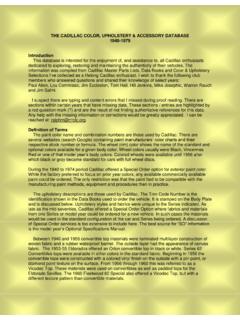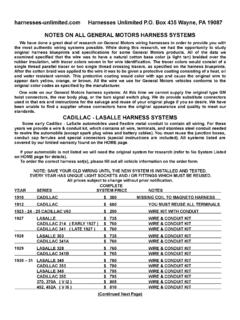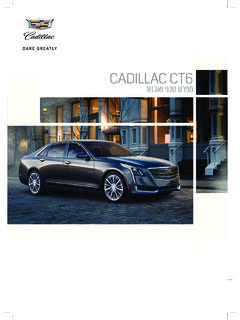Transcription of AC Cadillac hard red spring wheat - PGDC
1 CULTIVAR DESCRIPTIONAC Cadillac hard red spring wheatR. M. DePauw1, J. B. Thomas2, R. E. Knox1, J. M. Clarke1, M. R. Fernandez1, T. N. McCaig1,and J. G. McLeod11 Semiarid Prairie Agricultural Research Centre, Agriculture and Agri-Food Canada, Box 1030, SwiftCurrent, Saskatchewan, Canada S9H 3X2; 2 Lethbridge Research Centre, Agriculture and Agri-Food Canada, Box 3000, Main, Lethbridge, Alberta, Canada T1J 4B1. Received 14 July 1997, accepted 2 January , R. M., Thomas, J. B., Knox, R. E., Clarke, J. M., Fernandez, M. R., McCaig, T. N. and McLeod, J. G. 1998. AC Cadillachard red spring J. Plant Sci. 78: 459 462.
2 AC Cadillac , a hard red spring wheat (Triticum aestivumL.), is adaptedto the Canadian Prairies. It combines high grain yield with high grain protein concentration, heavy kernel and volume weights. Ithas improved resistance to leaf spots compared with the check cultivars, and resistance to prevalent races of leaf rust, stem rust,loose smut, and common bunt. AC Cadillac is eligible for grades of Canada Western Red spring words: Triticum aestivumL., red spring wheat , yield, protein, disease resistance, volume weightDepauw, R. M., Thomas, J. B., Knox, R. E., Clarke, J. M., Fernandez, M. R., McCaig, T. N. et McLeod, J.
3 G. debl de printemps roux vitreux AC Cadillac . Can. J. Plant : 459 462. AC Cadillac est un nouveau bl de printemps rouxvitreux (Triticum aestivumL.) qui convient aux conditions de culture des Prairies canadiennes. Tr s productif, son grain lourd pos-s de une teneur en prot ine et un poids sp cifique lev s. Par rapport aux cultivars t moins, il manifeste une meilleure r sistanceaux taches foliaires ainsi qu un bon niveau de r sistance aux races courantes de la rouille des feuilles, de la rouille noire, du char-bon nu et de la carie commune. Il est admissible la cat gorie des bl s de printemps roux de l ouest cl s: Triticum aestivumL.
4 , bl de printemps roux, rendement prot ine, r sistance aux maladies, poids sp cifiqueAC Cadillac , hard red spring wheat (Triticum aestivumL.),was developed jointly by Agriculture and Agri-FoodCanada, Semiarid Prairie Agricultural Research Centre,Swift Current, SK, and the Lethbridge Research Centre,Lethbridge, AB. AC Cadillac received registration No. 4376from the Food Production and Inspection Branch ofAgriculture and Agri-Food Canada on July 17, and Breeding MethodAC Cadillac derives from the cross BW90*3/BW553 madein 1987 at the Lethbridge Research Centre. BW90 is a lineselected from the cross BW15/BW38//BW40/RL4353(Campbell 1984).
5 BW553, a line developed by H. McKenzie(DePauw and Townley-Smith 1981), carries the Bt10 genewhich confers resistance to common bunt [caused by TilletialaevisKuhn in Rabenh. and T. caries(DC.) Tul. & C. Tul.].The cross was made to recombine the Bt10 gene, the CWRS gluten strength, and the kernel type of BW553 with the highyield potential and the high protein concentration of F1seeds from the first backcross were inoculated withthe T19 race of bunt (avirulent on Bt10), and all bunt-freeplants were crossed again with BW90. Further inoculation ofBC2F1and BC2F2plants with T19 was conducted to identi-fy bunt-free BC2F1-derived populations presumably carryingBt10.
6 The F3seed of several hundred bunt-free BC2F2-derived representatives of the best BC2F1-derived familieswere screened for bunt in field nurseries at Lethbridge andSwift Current. Bunt-free plants were selected and multipliedas BC2F2-derived BC2F4bulks in a winter nursery nearBrawley, California. The BC2F5bulks were screened forquantitative and qualitative traits using early generationscreening procedures. We practised simultaneous selectionfor grain yield potential and grain protein concentration:grain yield potential was measured by growing replicated tri-als at two locations; grain protein concentration was assessedon a composite of the two replications from each locationusing near infrared reflectance spectroscopy.
7 Reaction to leafrust (caused by Puccinia reconditaRoberge ex Desmaz.) andstem rust (caused by P. graminisPers.:Pers. f. sp. triticiEriks. & E. Henn.) was measured in an epiphytotic diseasenursery near Glenlea, MB. Reaction to bunt was done in aspecial nursery. Bunt-free plants were used to establish head-to-row progeny in a winter nursery in 1989 1990. Remnantseed from the yield trials was used to assess grain quality andkernel characteristics. The BC2F5-derived BC2F7was han-dled in the same manner as the BC2F5except that BC2F7lines, selected on the basis of agronomic performance, pro-tein concentration and reaction to rust, were screened forreaction to loose smut (caused by Ustilago tritici[Pers.)]
8 ]Rostr.) and common bunt. An experimental line, designatedas L8900-AL2A10, was evaluated in the Western BreadWheat A Test in 1991, and the Western Bread wheat B Test in 1992. It was designated BW689 and evaluated in theWestern Bread wheat Cooperative Test from 1993 to in the Cooperative Test, reaction to leaf and stemrust was measured in an epiphytotic disease nursery near459460 CANADIAN JOURNAL OF PLANT SCIENCEG lenlea, MB. The stem rust races used were QTH(C25),TPM (C53), TMR (C10), TMR (C95), RHT (C57), RKQ(C63). The races of leaf rust used were CGB, KBG, MCR,MFB, MFM, TBD, TBG, and TDT (Kolmer 1996).
9 RacesT2, T9, T10 and T39 of loose smut and races L1, L16, T1,T13, and T19 of Common bunt were used for screening. Therace designations are those described by Green (1965) andRoelfs and Martens (1988) for stem rust, Hoffman andMetzger (1976) for common bunt, and Nielsen (1987) forloose smut. Response to leaf spots was scored followingprocedures described by Fernandez et al. (1996).PerformanceIn the Western Bread wheat Cooperative Test from 1993 to1995, AC Cadillac yielded significantly more than all thechecks, except Laura (Table 1). In Zone 1, AC Cadillacaveraged more grain than Neepawa, more thanKatepwa, more than AC Eatonia, and more thanLaura.
10 In Zone 2, it yielded more grain than Neepawa, more than Katepwa, more than AC over both zones, AC Cadillac matured about 2 dearlier than Laura and about 1 d later than Neepawa andKatepwa. It was about 3 cm taller than Neepawa andKatepwa and 5 cm taller than Laura. AC Cadillac had strawstrength intermediate to Katepwa, Neepawa and Laura, andsignificantly stronger than AC Eatonia. AC Cadillac hadsignificantly heavier volume weight and kernel weight thanall checks. It expressed resistance to common bunt, loosesmut, leaf rust and stem rust (Table 2). Its protein concen-tration was equal to that of Laura and AC Eatonia, andgreater than that of Neepawa and Katepwa (Table 3).






